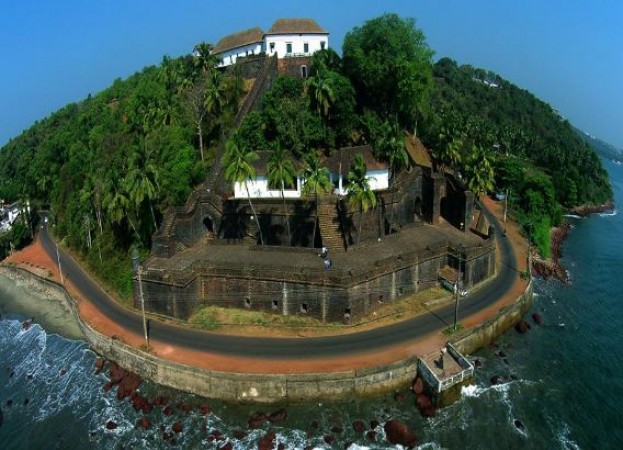
Goa has become synonymous with gorgeous beaches, sumptuous seafood, and crazy night-long parties. There’s something about the laid-back sun-and-sea ambiance of Goa that never leaves you bored, even after repeated visits. But, the party capital of India is alive with other treasures as well, if only you care to look around! One such treasure is its mighty forts. While some of these historical forts are tourist hotspots, there are several others that remain in the shadows of Goa’s vibrant avatar. Yet, each of these forts has a story to tell and are impressive enough to make you stand and wonder. We present to you the top forts in Goa that talk magnificence.
Chapora Fort
It is located 10 km away from Mapusa, is undeniably one of the most famous forts in Goa. Built by the Portuguese in 1717, Chapora Fort has a long and fascinating history attached to it. More popularly known as the 'Dil Chahta Hai Fort', its claim to fame was the 2001 Bollywood blockbuster shot here. A scintillating escape, it offers beautiful views of the sea and Chapora River.
The fortifications around the current location of Chapora Fort existed long before the Portuguese even landed in Goa. It was originally built by Muslim ruler Adil Shah and was called Shahpura. The fort was later reconstructed by the Portuguese who named it Chapora, after the Chapora River that flows right alongside it. The highlight of the fort is the breathtaking view of the adjoining Vagator beach overlooking the Arabian Sea, especially at sunset. However, reaching the top of the now-ruined fort requires a steep 10-minute climb.
Chapora Fort has passed through the possession of numerous rulers over a long period of time, right from the Portuguese to the Marathas and the ruins tell a story of their own! You can still see the entry points of the two tunnels that were built by the Portuguese to use as an escape in times of emergency.
Also Read: Romania :A Land of Rich History, Natural Beauty, and Vibrant Culture
Fort Aguada
Fort Aguada is a 17th-century Portuguese fort looking out at the confluence of Mandovi River and the Arabian Sea. The crumbling ramparts of the fort stand on the Sinquerim Beach, approximately 18 km from Panjim. The highlight of the fort is a lone four-storey lighthouse (which is one-of-its-kind in Asia )and a stunning view of the sunset.
Built-in 1612 as a protection from Dutch and Marathas, Fort Aguada was the most prized and crucial fort for the Portuguese and covers the entire peninsula at the southwestern tip of Bardez. The fort is so named after the Portuguese Word for water i.e. 'Agua' and used to be a replenishing source of freshwater for sailors. In fact, it has the capacity to hold 2,376,000 gallons of water and was one of the biggest freshwater reservoirs of Asia.
Fort Aguada has also been used as Aguada jail. A statue in front of the jail salutes the freedom fighters, giving the fort a touch of patriotism.
Also Read: Volcano Manor Beckons: Unleash the Explorer Within You
Tiracol Fort
Whether you call it Tiracol Fort or Terekhol Fort, it is a famous fort in Goa that offers you a sweeping view of the countryside. Gracing the Tiracol River at its mouth, the spectacular fort was once a crucial part of Portuguese maritime defenses. It will take you a ferry ride from Querim to reach the location of this fort. It was Maharaja Khem Sawant Bhonsle, the ruler of Sawantwadi, who built this magnificent structure in the 17th century. In those initial days, the fort boasted a barrack, 12 guns, and a tranquil chapel, but much has changed since then. The fort suffered extensive damage and lost its charm to a certain level.
However, not all is lost! Today it has been converted into a heritage hotel with the aim to preserve its beauty and offer tourists a chance to stay inside this heritage structure. Even the church is present inside the fort complex, but its doors are opened to welcome the general public only on certain special occasions.
Also Read: Suez, Egypt: Suez is a Seaport City
Mormugao Fort
It is one of the top coastal forts in Goa, located at Mormugao port, a few km from Vasco de Gama. A popular tourist attraction, it was built in the early 17th century by the Portuguese to protect the Margoa Port. Overlooking the Varca Beach, the grand fort commands a fabulous view of the scenic landscape and the beautiful Arabian Sea.
Though most of the fort is presently in ruins, the bastions and bulwarks still stand tall and fortify the area. There are also two stunning fountains here - Fonte de Malabar and the Fonte Santo Ignacio. These are believed to have originated from a gold and sulphur mine. The original fort included towering bulwarks, prison blocks and accommodation for the garrison.
Also Read: Warsaw: The Resilient Heart of Poland
Cabo de Rama Fort
It is located in the Canacona region of South Goa, Cabo de Rama is a 17th-century Portuguese fort associated with the legend of Ramayana. It is believed that Lord Rama, Goddess Sita and Lord Lakshmana lived in the fort during their 14-year exile. Though most of the fort is now in ruins, it is a popular tourist attraction as it offers a stunning view of South Goa.
Cabo de Rama Fort was built by the Hindu Soonda Rulers, however, in the 1760s; it was captured by the Portuguese and used as a military base and later as a prison. It, therefore, is also a historically significant monument in the country. There is a small chapel - church of Santo Antonio- at the entrance of the fort which is still used during the annual feast.
Also Read: Kom Ombo Temple: A Fascinating Ancient Marvel in Egypt